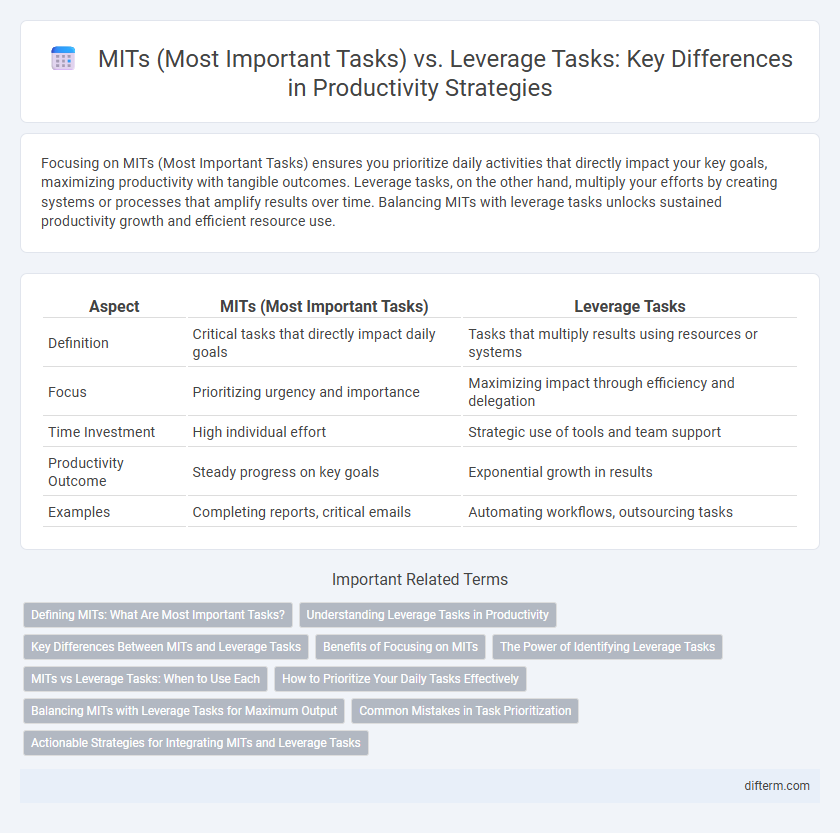Focusing on MITs (Most Important Tasks) ensures you prioritize daily activities that directly impact your key goals, maximizing productivity with tangible outcomes. Leverage tasks, on the other hand, multiply your efforts by creating systems or processes that amplify results over time. Balancing MITs with leverage tasks unlocks sustained productivity growth and efficient resource use.
Table of Comparison
| Aspect | MITs (Most Important Tasks) | Leverage Tasks |
|---|---|---|
| Definition | Critical tasks that directly impact daily goals | Tasks that multiply results using resources or systems |
| Focus | Prioritizing urgency and importance | Maximizing impact through efficiency and delegation |
| Time Investment | High individual effort | Strategic use of tools and team support |
| Productivity Outcome | Steady progress on key goals | Exponential growth in results |
| Examples | Completing reports, critical emails | Automating workflows, outsourcing tasks |
Defining MITs: What Are Most Important Tasks?
Most Important Tasks (MITs) are the critical activities that generate the highest impact on your goals and productivity. Defining MITs involves identifying tasks that directly contribute to significant progress and prevent distractions from low-value work. Prioritizing MITs ensures focused effort on actions that drive meaningful results and long-term success.
Understanding Leverage Tasks in Productivity
Leverage tasks in productivity refer to actions that generate disproportionate results compared to the effort invested, making them essential for maximizing output. Unlike Most Important Tasks (MITs), which are prioritized based on urgency or significance, leverage tasks focus on high-impact activities that multiply progress. Identifying and consistently executing leverage tasks unlocks exponential growth in efficiency and goal attainment.
Key Differences Between MITs and Leverage Tasks
MITs (Most Important Tasks) are high-priority activities that directly impact daily goals and require immediate attention, while leverage tasks generate exponential results by optimizing processes or resources for long-term efficiency. MITs focus on completing essential, time-sensitive actions, whereas leverage tasks involve strategic efforts that multiply productivity beyond the initial effort. Understanding the distinction allows individuals to balance urgent tasks with influential actions that maximize overall output.
Benefits of Focusing on MITs
Focusing on Most Important Tasks (MITs) drives higher productivity by ensuring priority activities directly impact key goals, reducing time wasted on low-value work. MITs bring clarity and focus, enabling efficient decision-making and preventing overwhelm from multitasking. This targeted approach maximizes output quality and accelerates progress toward critical objectives.
The Power of Identifying Leverage Tasks
Identifying leverage tasks maximizes productivity by targeting activities that generate the greatest impact with the least effort, unlike MITs (Most Important Tasks) which focus solely on priority without considering potential multiplier effects. Leveraging tasks involves strategic prioritization, allowing professionals to amplify results and accelerate progress more efficiently. Businesses that master leverage tasks experience enhanced output and sustained growth through optimized resource allocation.
MITs vs Leverage Tasks: When to Use Each
MITs (Most Important Tasks) demand focused attention to drive critical progress on key goals, ideal for high-impact deadlines or complex projects requiring deep work. Leverage tasks amplify efficiency by delegating or automating actions that yield significant results with less personal effort, suitable for routine or scalable processes. Prioritize MITs during strategic planning phases and deploy leverage tasks to maximize productivity in operational workflows.
How to Prioritize Your Daily Tasks Effectively
Prioritizing your daily tasks effectively involves distinguishing between MITs (Most Important Tasks), which directly impact your core goals, and leverage tasks that amplify overall productivity by influencing multiple areas. Focusing on MITs ensures critical objectives are met, while strategically allocating time to leverage tasks maximizes resource efficiency and accelerates long-term progress. Employing a prioritization matrix combining urgency, impact, and leverage helps create a balanced workflow that drives meaningful results.
Balancing MITs with Leverage Tasks for Maximum Output
Balancing Most Important Tasks (MITs) with leverage tasks enhances productivity by combining high-priority actions with efforts that multiply results. MITs drive focus on crucial goals, while leverage tasks generate exponential impact through strategic use of resources or delegations. Integrating both ensures sustained progress and maximizes overall output efficiently.
Common Mistakes in Task Prioritization
Common mistakes in task prioritization include confusing MITs (Most Important Tasks) with leverage tasks, leading to inefficient use of time and resources. MITs demand immediate attention due to their high impact on critical goals, while leverage tasks amplify productivity by creating ripple effects across multiple projects. Misallocating effort to low-impact leverage tasks or deferring MITs results in missed deadlines and stagnant progress in productivity management.
Actionable Strategies for Integrating MITs and Leverage Tasks
Prioritizing Most Important Tasks (MITs) ensures focus on high-impact activities that drive core goals, while leveraging tasks maximize efficiency by utilizing resources and delegation. Integrate MITs with leverage tasks by scheduling MITs during peak energy periods and assigning or automating leverage tasks to free time for those critical actions. Implementing tools like task batching and time-blocking enhances this synergy, optimizing both personal productivity and team output.
MITs (Most Important Tasks) vs Leverage tasks Infographic

 difterm.com
difterm.com